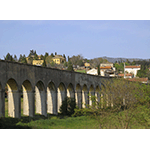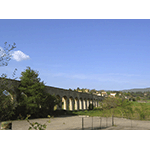Aqueducts of Arezzo
Perceived since the dawn of time in every urbanised centre, the problem of water supply was also confronted in Arezzo since its very origin. There were Baths in the Roman epoch, but very few traces remain today of the aqueduct that we presume supplied them. The so-called Vasari aqueduct, built between 1593 and 1603, conformed quite well to the structure of the Arezzo territory. In the lower part of the valley, the aqueduct passed along a series of arches, while an underground canal transported water through the hill to the foot of the fortress of Arezzo. In place of blow-holes in the underground canal, the height of the water pipe was considerably increased, and the waters flowing from the mouths of the Public Fountain supplied the fountains in Piazza di San Agostino, a large wash-house and the fulling-mills in the area.
The arches of the Vasari aqueduct can still be admired today in good repair on the north-eastern outskirts of Arezzo in the locality of "Gli Archi". Between 1925 and 1929, the Commune of Arezzo ordered the construction of the new "Buon Riposo" Aqueduct in order to supplement the previous conduit in case of necessity. In 1930, the Fraternita dei Laici, owner of the Vasari aqueduct, surrendered it to the Commune so that the system of water management could be unified.
****************************
Texts by Mara Miniati
English translation by Victor Beard
Last update 27/feb/2008





